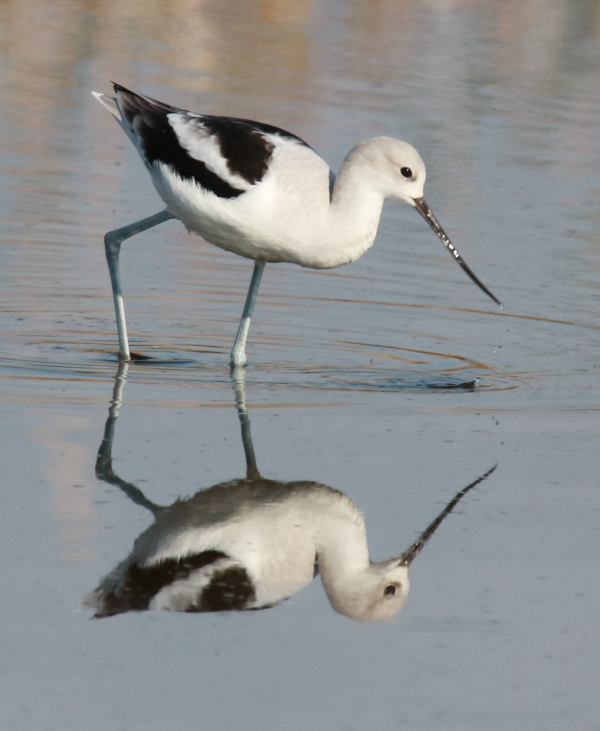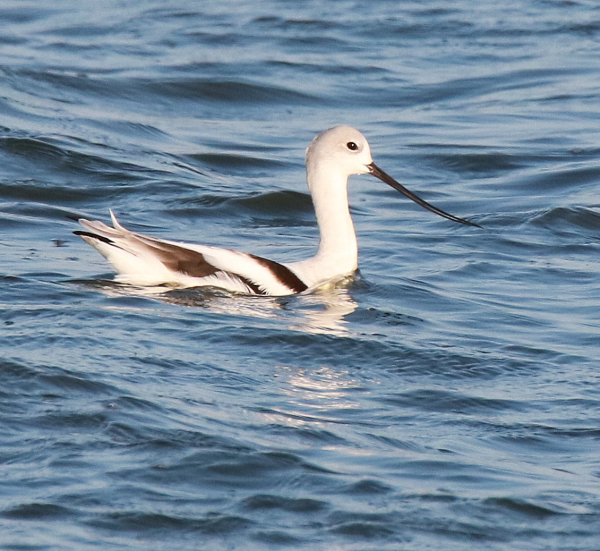
American Avocets were willing photo subjects while they foraged in shallows and deeper water.

Avocets tend to prefer shallow water, but they are good swimmers when they find food in deeper water. Their feet are actually webbed, aiding in their locomotion beyond the shallows.

Two of the 6 Black-billed Magpies that provided a rare find beyond the Missouri River Valley.
|
The Lost Road was full of surprises last weekend, starting Saturday with a super-rare sighting in these parts: a Black-billed Magpie flew out from a nearby buffalo berry bush. That’s very rare, but what made it super-rare is that the first magpie was followed by 2 more, and 2 more, and yet another – all from the same little bush! They flew together over the broad prairie hills, perhaps a family group, perhaps following the escarpment. Sunday a pair of American Kestrels caught my attention at first, and a mile father an exciting dark morph hawk flew from a lone cottonwood that could have been a Red-tail, or even a Ferruginous Hawk. I took a couple photos as the black hawk took a straight-line flight to the north, hoping to get a positive identification in my computer darkroom.
The significance of the magpie and hawk sightings was great: Magpies are rarely seen east of the Missouri River Valley in North Dakota – that’s 60 miles west, and I haven’t seen a magpie in this area of southeast Dakota for years, although the single magpies I saw then were along the Coteau escarpment, but a number of miles farther south; never around the Lost Road.
As for the dark morph Buteo hawk, it was early for a Harlan’s Red-tail sighting and I couldn’t ascertain that it was a Harlan’s Red-tail, the usual dark morph option east of the Rockies. A dark morph western Red-tail would be extremely rare in the northeastern Great Plains. But a dark morph Ferruginous Hawk would be astronomically rare. I took documentary photos of the black hawk expressly to get a better look for a positive I.D., so in my laptop computer darkroom I verified it was the most likely raptor – an early dark morph Harlan’s Red-tailed Hawk – nice!
American Kestrels were making an obvious push through the area with up to 5 per birding drive Friday through Sunday afternoons. There were fewer Red-tails in the area, but more Northern Harriers it seemed. During the next 2 weeks I’m hoping for a few Peregrine Falcon sightings – it’s their time – and even 1 will be a thrill. There was only 1 Swainson’s Hawk along my route Sunday, suggesting many may be on their way south toward Argentina.
Other prominent birds in the area were widely scattered Western Meadowlarks, Greater Yellowlegs, Killdeer, American Avocets, Great Egrets, White-faced Ibis, Great Blue Herons, White Pelicans, Double-crested Cormorants, and flocks of Yellow-headed Blackbirds; plus Giant Canada Geese and ducks – mostly Mallards, Blue-winged Teal, a few Wood Ducks, and a variety of others. On my way home Sunday, I observed another first-fall Red-headed Woodpecker far from any previous Red-head sightings; and there were 2 Cattle Egrets at the heels of a few cattle, and an adult Bald Eagle was perched on a tall snag at a favorite deep lake to the north.
Window Waves
Immediately as I emerged from my bedroom Sunday morning, I spied a Brown Creeper and a Tennessee Warbler in my bay window ash tree – that perked me up. A closer look showed there were several Tennessee Warblers active in the tree along with a White-breasted Nuthatch. Next a first of season Dark-eyed Junco and Lark Sparrow flew up, leaving a few Chipping Sparrows on the ground. The parade of birds over the next half-hour included a few American Goldfinches in basic plumage, the first couple House Finches I’ve seen in a few weeks, a couple Yellow-rumped Warblers, a female Downy Woodpecker, a few more Tennessee Warblers, and a Red-breasted Nuthatch – what fun.
Earlier in the week, the only neotropical migrant I caught sight of was a lone Tennessee Warbler, but I was really happy to see the first Hairy Woodpecker since spring visit my suet feeder, a male that joins male and female Downy Woodpeckers, and a White-breasted Nuthatch or 2 daily.
Monday morning was nearly a repeat of Sunday as I walked out of my bedroom to see a wave of songbirds before I could wipe the sleep from my eyes. As my eyes focused I realized a tight flock of Orange-crowned Warblers was foraging through my ash trees dodging sprinkling raindrops, and continuing into the sumac grove – what a treat. That’s when I enjoyed views of Orange-crowns within just a couple feet, and when I sighted a young Red-eyed Vireo just 5 feet away. They collectively worked their way to my backyard, so with the light rain, I opted to check the action from my second story windows. Not sure what happened to the Orange-crowns, but there were several Yellow-rumped Warblers working through the tall blue spruce, ash trees, and sumac.
With a northwest wind and rain overnight, and intermittent rain and sprinkles now, the warblers were probably short-stopped during an early morning flight. The migrants always pass by way too fast, but a male, then a female Downy Woodpecker ate at the no-melt hot chili suet feeder, and they were followed by a pair of White-breasted Nuthatches. A lone Orange-crowned Warbler also visited the adjacent ash tree to forage among the leaves and seed clusters as the sprinkles subsided and the wind picked up after noon.
I close this week’s issue on the last day of summer, and greet the official calendar start of fall as the first golden ash leaves grace my ash trees, along with red foliage of the wild grape
vines that climb high into upper branches of the eastern-most ash. As for the birds, many began their fall migrations in August, and I look forward to new sightings to share each week out my windows and down the road.
I must admit I intended to make a pilgrimage east to Duluth, Minnesota last week to catch a glimpse of the raptor and songbird migrations during the peak of Broad-winged Hawk flights, but a number of things kept me centered on the Dakota prairies. Maybe later in the season – the Broad-wings will have passed, but a wealth of other birds will continue to work their way along the shore of Lake Superior and through the Northwoods. Wherever you go birding this week, I hope you enjoy some beautiful fall experiences.
Article and photos by Paul Konrad
Share your bird sightings and photographs at editorstbw2@gmail.com